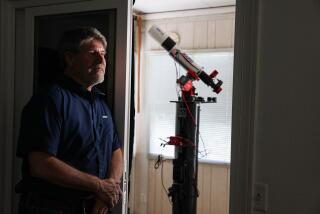Giant supernova in the sky smashes previous record, stuns scientists
- Share via
There’s breaking a record, and then there’s blowing it to smithereens. Astronomers using relatively small telescopes around the globe have spotted the brightest supernova ever seen, shining about 20 times brighter than the 100 billion stars in the entire Milky Way galaxy — or, put another way, as bright as 570 billion suns.
The discovery of ASASSN-15lh, described in the journal Science, tests the limits of our understanding of the dramatic deaths of powerful stars.
“This may be the most powerful supernova ever seen by anybody … it’s really pushing the envelope on what is possible,” said study co-author Krzysztof Stanek, an astronomer at Ohio State University.
See more of our top stories on Facebook >>
Supernovae happen when a dying star explodes, sending loads of its supercharged stellar guts out into the surrounding universe. Depending on the type of supernova, different heavy elements, such as gold and other precious metals, are forged in these powerful explosions and spread throughout the cosmos, seeding other stars and their planets. (It’s why Carl Sagan said that we are “made of star stuff.”)
These dramatic events can sometimes shine even brighter than the galaxies that house them, typically lasting for several weeks before fading away. But this newly discovered supernova steals the spotlight — it’s at least twice as bright as the previous record holder, and it has lasted for several months. Compared to a typical supernova, ASASSN-15lh shines about 200 times brighter.
ASASSN-15lh is thought to have gone critical in May, but was first spotted in June of last year using the All Sky Automated Survey for Supernovae (ASAS-SN), based out of Ohio State. The survey uses smaller telescopes to scan the sky every two to three days, searching for changes in the heavens. If some new bright object pops up, they’ll catch it, and astronomers can then use bigger telescopes to take a better look.
“We actually had it for a few weeks before we even noticed it because this really was very marginal detection,” Stanek said. “It actually took us another few weeks to realize we had an extreme case of a supernova because at first you don’t really know what was happening.”
To calculate the power of this supernova, the researchers needed to find the distance to it. If this apparently dim object was close by, it must have been fairly weak. But if it was far away, then the dim-looking object must actually have been quite powerful, for its light to reach all the way to Earth. The scientists took a spectrum of the supernova from the 10-meter South African Large Telescope and found that the supernova was some 3.8 billion light years away. This thing was really, really bright.
ASASSN-15lh must be a superluminous supernova, an incredibly bright type of exploding star that astronomers have been finding in recent decades. Researchers think these superluminous supernovae are caused by magnetars — rotating neutron stars with powerful magnetic fields, which help amp up the star’s brightness. But ASASSN-15lh’s extreme luminosity seems to stretch the limits of that explanation. A magnetar based supernova of this magnitude could only happen under a “perfect storm” of events, including an incredibly strong magnetic field and a blazing fast spin rate.
If that’s the case, “this record might hold for a while because it’s kind of a really extreme case of what can happen if everything goes just right for producing a very powerful supernova,” Stanek said.
It’s possible that there’s an entirely different explanation for this superluminous supernova, a possibility that Stanek said he welcomed.
“A magnetar barely works, but it might be the best explanation,” Stanek said. “As an observer, I don’t really care about the best possible explanation; I actually want to break that model because then it will force people to come up with something better. But we’re not there yet. The exciting thing about this one is that even the magnetar model might not even work.”
Follow @aminawrite on Twitter for more science news and “like” Los Angeles Times Science & Health on Facebook.
ALSO
Frog communication goes way beyond ‘ribbit,’ scientists say
Another Rosetta first! Water ice found on the surface of comet 67P
A ‘moonshot’ to cure cancer: Realistic hope or a search for green cheese?







